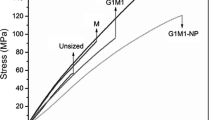Abstract
Tensile properties of epoxy casts together with shape memory alloy (SMA), glass (GF) and carbon (CF) woven fabric reinforced epoxy matrix super hybrid composites were investigated, respectively. In order to enhance the mechanical strength of this advanced material, two categories of modifications including matrix blending and fiber surface coating by nano-silica were studied. Scanning electron microscopy (SEM) and fiber pull-out tests were adopted to complement the experimental results, respectively. Experimental results reveal that the toughness of epoxy matrix is enhanced significantly by adding 2wt% nano-silica. The failure mechanism of SMA reinforced hybrid composites is different from that of GF/CF/epoxy composites. Compared with the matrix modification, the fibers modified by coating nano-silica on the surface have better tensile performances. Moreover, the fiber pull-out test results also indicate that composites with fiber surface modification have better interfacial performances. The modification method used in this paper can help to enhance the tensile performance of the mentioned composite materials in real engineering fields.
Similar content being viewed by others
References
Lei H, Wang Z, Tong L, et al. Experimental and Numerical Investigation on the Macroscopic Mechanical Behavior of Shape Memory Alloy Hybrid Composite with Weak Interface[J]. Composite Structures, 2013, 101: 301–312
Zhou G, Lloyd P. Design, Manufacture and Evaluation of Bending Behaviour of Composite Beams Embedded with SMA Wires[J]. Composites Science and Technology, 2009, 69(13): 2 034–2 041
Taheri-Behrooz F, Taheri F, Hosseinzadeh R. Characterization of a Shape Memory Alloy Hybrid Composite Plate Subject to Static Loading[J]. Materials & Design, 2011, 32(5): 2 923–2 933
Aurrekoetxea J, Zurbitu J, de Mendibil I O, et al. Effect of Superelastic Shape Memory Alloy Wires on the Impact Behavior of Carbon Fiber Reinforced in Situ Polymerized Poly (Butylene Terephthalate) Composites[J]. Materials Letters, 2011, 65(5): 863–865
Raghavan J, Bartkiewicz T, Boyko S, et al. Damping, Tensile, and Impact Properties of Superelastic Shape Memory Alloy (SMA) Fiberreinforced Polymer Composites[J]. Composites Part B: Engineering, 2010, 41(3): 214–222
Lei H, Wang Z, Zhou B, et al. Simulation and Analysis of Shape Memory Alloy Fiber Reinforced Composite Based on Cohesive Zone Model[J]. Materials & Design, 2012, 40: 138–147
Davies GAO, Zhang X. Impact Damage Prediction in Carbon Composite Structures[J]. International Journal of Impact Engineering, 1995, 16(1): 149–170
Imielińska K, Castaings M, Wojtyra R, et al. Air-coupled Ultrasonic C-scan Technique in Impact Response Testing of Carbon Fibre and Hybrid: Glass, Carbon and Kevlar/epoxy Composites[J]. Journal of Materials Processing Technology, 2004, 157: 513–522
Kim JK, Sham ML, Sohn MS, et al. Effect of Hybrid Layers with Different Silane Coupling Agents on Impact Response of Glass Fabric Reinforced Vinylester Matrix Composites[J]. Polymer, 2001, 42(17): 7 455–7 460
Dehkordi MT, Nosraty H, Shokrieh MM, et al. The Influence of Hybridization on Impact Damage Behavior and Residual Compression Strength of Intraply Basalt/Nylon Hybrid Composites[J]. Materials & Design, 2013, 43: 283–290
Bhatia NM. Strength and Fracture Characteristics of Graphite-glass Intraply Hybrid Composites[C]. In: Composite Materials: Testing and Design (6th Conf), ASTM STP. 1982, 787: 183–199
Park R, Jang J. The Effects of Hybridization on the Mechanical Performance of Aramid/Polyethylene Intraply Fabric Composites[J]. Composites Science and Technology, 1998, 58(10): 1 621–1 628
Pegoretti A, Fabbri E, Migliaresi C, et al. Intraply and Interply Hybrid Composites Based on E-glass and poly (vinyl alcohol) Woven Fabrics: Tensile and Impact Properties[J]. Polymer International, 2004, 53(9): 1 290–1 297
Akhbari M, Shokrieh MM, Nosraty H. A Study on Buckling Behavior of Composite Sheets Reinforced by Hybrid Woven Fabrics[J]. Transactions-canadian Society For Mechanical Engineering, 2008, 32(1): 81
Dehkordi MT, Nosraty H, Shokrieh MM, et al. Low Velocity Impact Properties of Intra-ply Hybrid Composites Based on Basalt and Nylon Woven Fabrics[J]. Materials & Design, 2010, 31(8): 3 835–3 844
Sreekumar PA, Thomas SP, Marc Saiter J, et al. Effect of Fiber Surface Modification on the Mechanical and Water Absorption Characteristics of Sisal/Polyester Composites Fabricated by Resin Transfer Molding[J]. Composites Part A: Applied Science and Manufacturing, 2009, 40(11): 1 777–1 784
Alvarez VA, Vázquez A. Influence of Fiber Chemical Modification Procedure on the Mechanical Properties and Water Absorption of MaterBi-Y/Sisal Fiber Composites[J]. Composites Part A: Applied Science and Manufacturing, 2006, 37(10): 1 672–1 680
Demir H, Atikler U, Balköse D, et al. The Effect of Fiber Surface Treatments on the Tensile and Water Sorption Properties of Polypropylene-luffa Fiber Composites[J]. Composites Part A: Applied Science and Manufacturing, 2006, 37(3): 447–456
Zhang H, Tang LC, Zhang Z, et al. Fracture Behaviours of in Situ Silica Nanoparticle-filled Epoxy at Different Temperatures[J]. Polymer, 2008, 49(17): 3 816–3 825
Zhang H, Zhang Z, Friedrich K, et al. Property Improvements of in Situ Epoxy Nanocomposites with Reduced Interparticle Distance at High Nanosilica Content[J]. Acta Materialia, 2006, 54(7): 1 833–1 842
Jiang Z, Siengchin S, Zhou LM, et al. Poly (Butylene Terephthalate)/ Silica Nanocomposites Prepared from Cyclic Butylene terephthalate[J]. Composites Part A: Applied Science and Manufacturing, 2009, 40(3): 273–278
Zhou LM, Mai YW, Baillie C. Interfacial Debonding and Fibre Pullout Stresses[J]. Journal of Materials Science, 1994, 29(21): 5 541–5 550
Author information
Authors and Affiliations
Corresponding author
Additional information
Funded by the National Natural Science Foundation of China (Nos.11302054 and 11472086), the Hong Kong, Macao and Taiwan Science and Technology Cooperation Projects of Ministry of Science and Technology of China (No.2014DFH50060), the Natural Science Foundation of Heilongjiang Province of China (No. A2015012) and the Fundamental Research Funds for the Central Universities(GK2010260256)
Rights and permissions
About this article
Cite this article
Zhao, S., Liang, W., Wang, Z. et al. Effect of nano-silica modification on the tensile property of SMA/GF/CF/epoxy super hybrid woven fabric composites. J. Wuhan Univ. Technol.-Mat. Sci. Edit. 32, 1293–1300 (2017). https://doi.org/10.1007/s11595-017-1744-1
Received:
Accepted:
Published:
Issue Date:
DOI: https://doi.org/10.1007/s11595-017-1744-1



